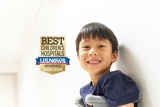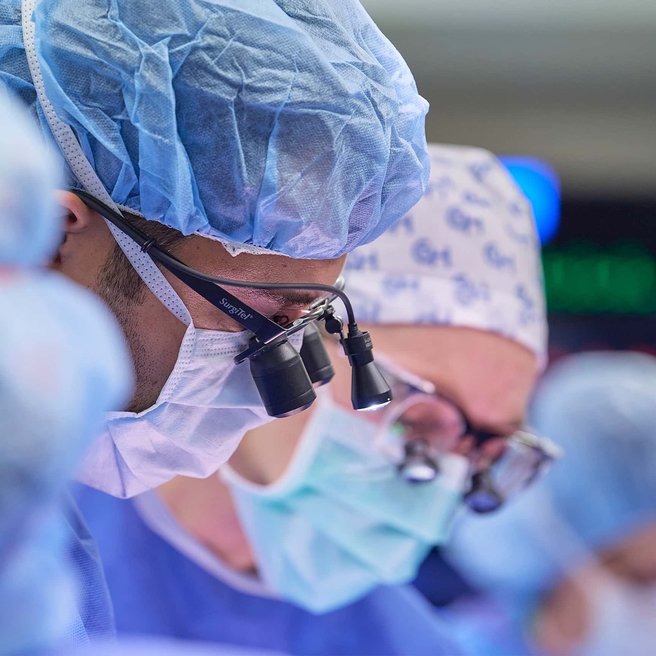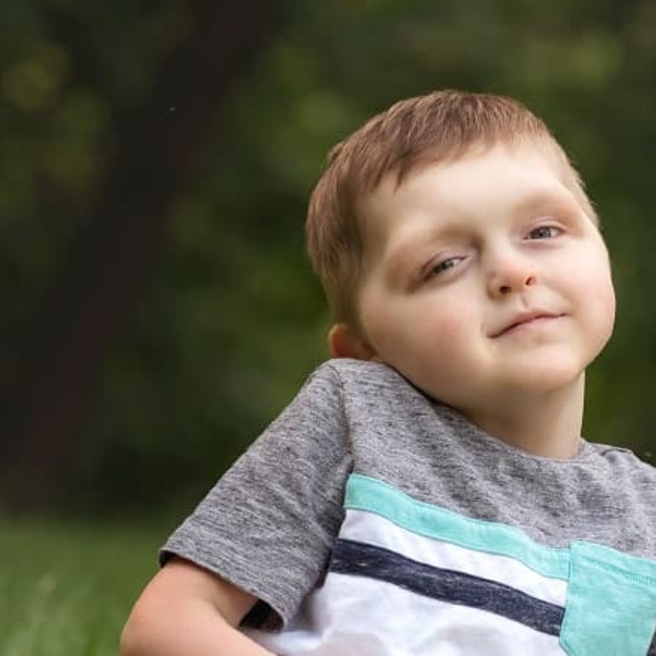What is kyphosis?
Kyphosis is a forward curvature of the spine in the upper back — best seen from the side, in contrast to scoliosis — giving a child an abnormally rounded or “humpback” appearance. It is a type of inflexible spinal deformity and should not be confused with poor posture or "round back," which is flexible.
Kyphosis and lordosis (an inward curvature of a portion of the lower spine) can be associated with early-onset scoliosis, a form of thoracic insufficiency syndrome. In thoracic insufficiency syndrome, a child's lungs do not get enough air because the spinal curves affect rib and lung growth and development.
Kyphosis can be congenital (present at birth) or caused by trauma, infection or underlying conditions such as:
- Congenital kyphosis caused by defects of vertebral development
- Metabolic problems (e.g., diabetes or thyroid disease)
- Neuromuscular conditions such as spina bifida, cerebral palsy and muscular dystrophy
- Scheuermann disease — a developmental disorder in adolescents in which spinal bones are wedged together, causing the spine to bow forward
- Slipping of one vertebra forward on another known as spondylolisthesis, usually found in the lower lumbar spine
- Tumor conditions such as neurofibromatosis
- Post laminectomy syndrome, a rare condition that develops in some patients who were previously surgically treated for cervical ossification
Signs and symptoms
Common symptoms of kyphosis include:
- Hump or curve to the upper back (thoracic spine)
- Difference in shoulder height and forward position
- Head bends forward compared to the rest of the body
- Difference in shoulder blade height or position
- When bending forward, the height of the upper back appears higher than normal
- Tight hamstring muscles (back of the thigh)
- Back pain
Testing and diagnosis
The normal spine naturally has curves of 20 to 50 degrees in the neck (cervical region of the spine), chest (thoracic region) and lower back (lumbar region). When the curves become more pronounced and the curve becomes abnormally convex (bowed out), the patient is described as having kyphosis.
Early detection of kyphosis is important to obtain the best outcome for your child. To determine if your child has kyphosis, an orthopedic physician will conduct a family and medical history, perform a physical examination and visual inspection of your child's back, and review any relevant radiological studies.
A diagnosis of kyphosis is made by detecting a severe curvature of the upper portion of your child's spine on an X-ray. If possible, we try to use adequate imaging without excessive radiation exposure.
Other diagnostic tests may include:
- Radioisotope bone scan or DEXA scan, which determines the health and strength of the spinal bone. CHOP's analysis of these scans is unique in that our clinicians compare your child's scan to normative data we have compiled from other children, not standard adult values.
- Magnetic resonance imaging (MRI), which uses a combination of large magnets, radiofrequencies and a computer to produce detailed images of organs and structures within the body. An MRI does not expose your child to radiation.
- Computed tomography (CT) scan, which uses a combination of X-rays and computer technology to produce cross-sectional images ("slices") of the body.
- EOS imaging, an imaging technology that creates 3-dimensional models from two planar images. Unlike a CT scan, EOS images are taken while the child is in an upright or standing position, enabling improved diagnosis due to weight-bearing positioning.
- Pulmonary function tests to determine lung capacity.
- Blood tests.
Treatments
At Children’s Hospital of Philadelphia (CHOP), we practice family-centered care in a collaborative environment. Our multidisciplinary team of experts includes world-renowned orthopedic surgeons and physicians, specially trained pediatric nurses, physical and occupational therapists, psychologists and other specialists. Together, we partner with you to provide the best care for your child.
We offer both surgical and nonsurgical treatments for kyphosis. The optimal treatment for your child will be determined based on the degree of curvature, the age and growth stage of your child, and whether the curve is getting progressively worse.
Nonsurgical treatment
For children who are still growing and have less severe spinal curvatures, a back brace may be prescribed as a nonsurgical treatment. The brace can help control your child's spine curvature. Physical therapy and anti-inflammatory medication may be prescribed in conjunction with the brace to extend your child's range of motion, as well as ease any pain or discomfort.
Surgical treatment
Surgery may be recommended when back bracing is not successful in slowing down the progression of the curve and rigid or progressive kyphosis greater than 80 degrees is detected.
Surgery can dramatically improve kyphosis, but can also be a stressful experience for your child and family. At CHOP, we offer a wealth of resources about how to prepare your child for surgery, what to expect during surgery and specific ways we make safety in surgery a top priority.
The most common surgical treatments for kyphosis include:
- implanting growing rods
- implanting vertical expandable prosthetic titanium ribs (VEPTR)
- performing a spinal fusion
Determining which surgery is right for your child will depend on your child's age and skeletal maturity, along with other medical considerations.
Growing rods and VEPTR
If your child is still growing, either implanting growing rods or implanting vertical expandable prosthetic titanium ribs (VEPTR) will likely be the recommended treatment. Both devices — once surgically implanted — can be adjusted in minor surgery as your child grows.
Growing rods are the more traditional treatment in which one or two metal rods are inserted into the child's back. The rods are placed under the skin to avoid damaging the growth tissue of the spine and are attached to the spine at two spots — above and below the curve.
VEPTR is a newer treatment that was invented and pioneered by one of CHOP’s own pediatric orthopedic surgeons. The VEPTR was created specifically as a lifesaving treatment for thoracic insufficiency syndrome, in which a child's spinal curve is severely affecting lung growth. If left untreated, thoracic insufficiency syndrome can be fatal.
If your child has kyphosis and early-onset scoliosis, clinicians will likely recommend VEPTR implantation.
In VEPTR surgery, the expandable titanium ribs are implanted into your child's back and chest, and anchored to the spine, ribs, pelvis or collar bone. The VEPTR helps to correct and stabilize the curved spine, allowing your child's ribs, lungs and spine to grow and develop more fully.
Whichever device is implanted will need to be expanded or lengthened every six to eight months as your child grows and reaches skeletal maturity (about 14 years old for girls and 16 years old for boys).
Spinal fusion
Kyphosis correction and spinal fusion surgery may be recommended in older children when growing rods are not a consideration (usually after age 10) or after to permanently correct and stabilize the spine.
In spinal fusion surgery, the abnormal curved spinal bones may be realigned with metal rod implants inserted to correct the curvature, and the spinal correction made permanent with spinal fusion.
Follow-up care
After treatment — whether surgical or nonsurgical — the clinical team at CHOP will continue to follow-up on your child's care at our Main Campus or in one of our CHOP Care Network locations. Our team will meet with you regularly to review your child's progress and revise treatment goals as needed.
If back bracing was required, your child will be re-evaluated every six months until the spine is stable. After that point, annual visits to an orthopedic doctor are recommended.
If your child received growing rods or VEPTR surgery, an additional procedure — spinal fusion — may be necessary when your child has finished growing. Annual visits to an orthopedic doctor are recommended after spinal fusion.
At CHOP, we offer ongoing support and services for your child and family. Our team is committed to partnering with you to provide the most current, comprehensive and specialized care possible for your child.
We also recognize your child's pediatrician as an important part of the care team and will provide regular updates on your child's progress. If continued care is necessary as your child becomes an adult, we will help transition your child's care to an adult orthopedic team.
Outlook
With successful treatment and careful postoperative care, children with corrected kyphosis have excellent outcomes and can lead active, healthy lives.

Why choose CHOP
By sharing our surgical knowledge, clinical experience and innovative research, our program offers a depth and breadth of experience treating spine conditions that is unparalleled in the region.
Resources to help
Spine Program Resources
We have created video, audio and web resources to help you find answers to your questions and feel confident with the care you are providing your child.

